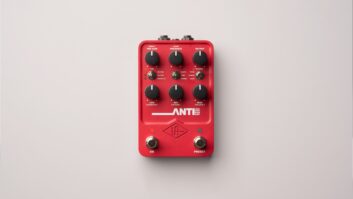SOUND REINFORCEMENT MONITOR CONSOLE
When it comes to headlines in the pro audio press, monitor consoles are rarely spotlighted; the “more important” house consoles generally get more attention. However, while FOH engineers typically need to focus on only one mix, monitor engineers may need to create four, five, six or more mixes simultaneously. Fortunately, monitor consoles have greatly improved over the years and often offer more complexity and features than FOH boards. Incorporating onboard mic splitting, low-noise circuitry, advanced feedback suppression capability and 10 mix output buses, the new Peavey SRM 2410 HC is an excellent example of that trend.
The SRM 2410 HC is a 24-input monitor board featuring 24 mic/line input channels (with phantom power switchable in three banks of eight channels). The 24 transformer-balanced input channels feature parallel male XLR “thru” splits on each channel (plus TRS send/return insert points), 4-band channel EQ with sweepable mid bands, and mute and PFL on every input. Each input includes an FLS (Feedback Locating System[R]) LED that indicates the channel with the highest level, and each of the eight mono submasters have an adjustable highpass filter, as well as two tunable notch filters and an FLS indicator to help identify the offending frequency.
In addition to the eight mono submasters, the Master section includes a stereo bus with pre/post switching and main L/R outputs addressable from any of the subgroups. A comprehensive talkback section allows the talkback to be routed to any of the output buses, and a ClearCom-compatible interface with standard 3-pin XLR intercom in/out connections, a 4-pin XLR headset jack and a large, bright “call” light eases integration with communications systems. Additional features include 12 peak reading LED output meters for the output buses and 12-volt XLR lamp sockets for board lights.
This 74-pound package is built into a 9.5×43.5×25.5-inch (HxWxD) Calzone ATA hard case (hence the “HC” in the SRM 2410 HC’s model number). The board’s internal universal power supply accepts any AC line source from 100 to 240V and ships with standard IEC AC cables with U.S.- and European-style plugs.
Setup and operations are straight forward. All of the main output bus signals appear on balanced XLR and unbalanced 1/4-inch jacks, and the input transformers provided clean, transparent splitting. Phase reverse (polarity switching) is only offered on 18 inputs (1-6, 9-14 and 17-22). The board has no concentric controls so it’s easy to navigate and make quick adjustments when necessary. The 75Hz lowpass filter and 4-band, 15dB channel EQ is flexible, with plenty of overlap in the two sweepable mid bands (100 to 3k and 500 to 15k Hz), while the fixed 12.5kHz and 80Hz points on the HF/LF shelving bands are both useful and musical. Also handy is a set of “wedge” outputs that provides a separate stereo bus for monitors at the mix position, driven directly from any PFL or AFL button.
The feature that sets the SRM 2410 HC apart from other monitor boards is the inclusion of the FLS LED tuning indicators and 2-band, narrow-Q notch filters on each of the monitor output channels. The notch filters have a -15dB attenuation range and are sweepable from 500 to 10k Hz (high band) and 100 to 4k Hz (low band). The filters have a sizeable overlap, allowing stacked use for deeper notching. And, if desired, an external EQ can be patched into the insert points for each output.
Three LEDs (left/center/right) below each notch filter band indicate how to sweep the filter’s frequency to eliminate feedback. If the left LED lights, then lower the frequency; if the right LED glows, then a higher frequency is required. Once the filter is set at the right frequency, all three LEDs light and the user merely adjusts the filter depth (attenuation) control until the feedback subsides. FLS is a simple, effective means of optimizing monitor levels, adding six to 10 Db of available gain, while system ringout can be handled in a matter of minutes.
My SRM 2410 HC want list is relatively short, with minor points such as differentiated channel EQ knobs (currently all six are the same color), including schematics and block diagrams in the manual and offering the board in a 32- or 40-input version for larger productions. Note: Peavey also makes the RQ1606M, a 16-channel monitor mixer with built-in (nontransformer) splits, FLS channel LEDs, adjustable HPF on the subs and retail price of $1,166.
But with its 10 monitor buses, clean audio performance, innovative feedback control and comprehensive set of pro features, the SRM 2410 HC offers a lot more than its $3,499 retail price would imply.
Peavey Electronics, 711 A Street, Meridian, MS 39301; 601/483-5365; fax 601/486-1278; www.peavey.com.







